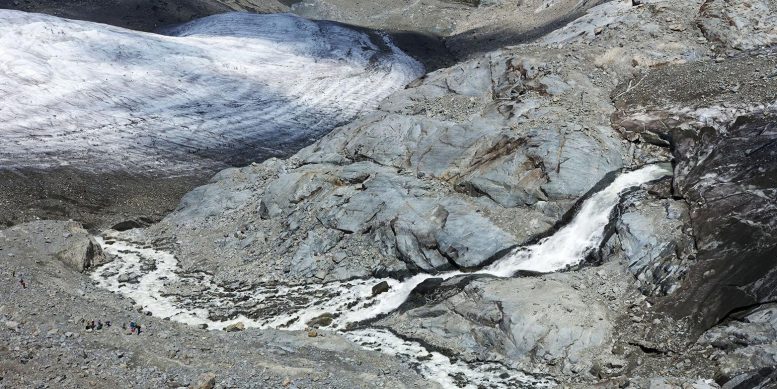
Rapid glacier melt: A roaring meltwater stream connects the Morteratsch and Pers Glaciers (r.), Engadine, Switzerland. A few years ago, the glaciers were connected. Credit: ETH Zurich
An international research team including scientists from ETH Zurich has shown that almost all the world’s glaciers are becoming thinner and losing mass’ and that these changes are picking up pace. The team’s analysis is the most comprehensive and accurate of its kind to date.
Glaciers are a sensitive indicator of climate change – and one that can be easily observed. Regardless of altitude or latitude, glaciers have been melting at a high rate since the mid-20th century. Until now, however, the full extent of ice loss has only been partially measured and understood. Now an international research team led by ETH Zurich and the University of Toulouse has authored a comprehensive study on global glacier retreat, which was published online in Nature on April 28, 2021. This is the first study to include all the world’s glaciers – around 220,000 in total – excluding the Greenland and Antarctic ice sheets. The study’s spatial and temporal resolution is unprecedented – and shows how rapidly glaciers have lost thickness and mass over the past two decades.
Rising sea levels and water scarcity
What was once permanent ice has declined in volume almost everywhere around the globe. Between 2000 and 2019, the world’s glaciers lost a total of 267 gigatonnes (billion tonnes) of ice per year on average – an amount that could have submerged the entire surface area of Switzerland under six meters of water every year. The loss of glacial mass also accelerated sharply during this period. Between 2000 and 2004, glaciers lost 227 gigatonnes of ice per year, but between 2015 and 2019, the lost mass amounted to 298 gigatonnes annually. Glacial melt caused up to 21 percent of the observed rise in sea levels during this period – some 0.74 millimeters a year. Nearly half of the rise in sea levels is attributable to the thermal expansion of water as it heats up, with meltwaters from the Greenland and Antarctic ice sheets and changes in terrestrial water storage accounting for the remaining third.

Iceland’s glaciers – here Skaftafelljökull – have also rapidly lost mass over the past 20 years. Credit: P. Rüegg / ETH Zurich
Among the fastest melting glaciers are those in Alaska, Iceland, and the Alps. The situation is also having a profound effect on mountain glaciers in the Pamir mountains, the Hindu Kush, and the Himalayas.
“The situation in the Himalayas is particularly worrying,” explains Romain Hugonnet, lead author of the study and researcher at ETH Zurich and the University of Toulouse. “During the dry season, glacial meltwater is an important source that feeds major waterways such as the Ganges, Brahmaputra, and Indus rivers. Right now, this increased melting acts as a buffer for people living in the region, but if Himalayan glacier shrinkage keeps accelerating, populous countries like India and Bangladesh could face water or food shortages in a few decades.”
The findings of this study can improve hydrological models and be used to make more accurate predictions on a global and local scales – for instance, to estimate how much Himalayan glacier meltwater one can anticipate over the next few decades.
To their surprise, the researchers also identified areas where melt rates slowed between 2000 and 2019, such as on Greenland’s east coast and in Iceland and Scandinavia. They attribute this divergent pattern to a weather anomaly in the North Atlantic that caused higher precipitation and lower temperatures between 2010 and 2019, thereby slowing ice loss. The researchers also discovered that the phenomenon known as the Karakoram anomaly is disappearing. Prior to 2010, glaciers in the Karakoram mountain range were stable – and in some cases, even growing. However, the researchers’ analysis revealed that Karakoram glaciers are now losing mass as well.
Study based on stereo satellite images
As a basis for the study, the research team used imagery captured on board NASA’s Terra satellite, which has been orbiting the Earth once every 100 minutes since 1999 at an altitude of nearly 700 kilometers. Terra is home to ASTER, a multispectral imager with two cameras that record pairs of stereo images, allowing researchers to create high-resolution digital elevation models of all the world’s glaciers. The team used the full archive of ASTER images to reconstruct a time series of glacial elevation, which enabled them to calculate changes in the thickness and mass of the ice over time.
Lead author Romain Hugonnet is a doctoral student at ETH Zurich and the University of Toulouse. He worked on this project for nearly three years and spent 18 months analyzing the satellite data. To process the data, the researchers used a supercomputer at the University of Northern British Columbia. Their findings will be included in the next Assessment Report of the United Nations Intergovernmental Panel on Climate Change (IPCC), which is due to be published later this year. “Our findings are important on a political level. The world really needs to act now to prevent the worst-case climate change scenario,” says co-author Daniel Farinotti, head of the glaciology group at ETH Zurich and the Swiss Federal Institute for Forest, Snow, and Landscape Research WSL.
Reference: “Accelerated global glacier mass loss in the early twenty-first century” by Romain Hugonnet, Robert McNabb, Etienne Berthier, Brian Menounos, Christopher Nuth, Luc Girod, Daniel Farinotti, Matthias Huss, Ines Dussaillant, Fanny Brun and Andreas Kääb, 28 April 2021, Nature.
DOI: 10.1038/s41586-021-03436-z
Alongside the University of Toulouse, ETH Zurich and WSL, other institutions that participated in the study include Ulster University in the UK, the University of Oslo in Norway and the University of Northern British Columbia in Canada (please refer to the study for a complete list).









“What was once permanent ice …”
The ice has NEVER been “permanent!” There were few glaciers before the onset of the current Neogene Ice Age, which started at the beginning of the Pleistocene Epoch, about 2 million years ago. The continental ice sheets have waxed (Nebraskan, Kansan, Illinoian, and Wisconsin in North American) and then waned during the interglacials. During the current interglacial, alpine glaciers have periodically retreated such as during the Roman and Medieval warm periods, and after the LIA (Little Ice Age), and advanced (e.g. during the LIA). There are periods during which alpine glaciers are relatively static, but as they retreat from melting, they leave terminal moraines that show that the retreat is eposodic.
“Right now, this increased melting acts as a buffer for people living in the region, but if Himalayan glacier shrinkage keeps accelerating, populous countries like India and Bangladesh could face water or food shortages in a few decades.”
The other side of that coin is that if the climate were to turn cold and the glaciers again advanced, there would be reduced meltwater and that also would create water and food shortages! It is almost as if alarmists expect that the normal state of affairs is a static climate — that is, they are unconsciously denying that climate changes!
What is remarkable is how constant sea level rise has been for the last 7,000 years, with the only suggestion of an acceleration being when satellite measurements are appended to tide gauge measurements.
https://en.wikipedia.org/wiki/Meltwater_pulse_1A#/media/File:Post-Glacial_Sea_Level.png
Here come the anti-reality conservatives to say nothing bad is happening when it’s actually in reality very bad news.
Tell us, oh befuddled one, when has the climate EVER been unchanging?
“Anti-reality?” Really! You offer a personal opinion unsupported by any actual facts. Where is your reality? In your head only? Is there anything I said that you can point out as being wrong?
Do you not understand that the people living near the base of the Himalayas are living so close to the edge of sustainability that they will inevitably have problems? If the glaciers disappear, they won’t have adequate water. If warming stops, the water supply will decrease. If, in the unlikely probability that the climate is static for a long period and the water supply remains constant during that time, their growing population will have decreased water and food per capita.
If you fancy yourself the opposite of a “conservative,” which apparently you do, then you represent the political view that is incapable of analyzing a problem and understanding it. Instead, you wring your hands and look for a scapegoat, which in this case, you apparently think is anyone who has a different interpretation of the facts, and you call them an “anti-reality conservative.” Then there is the alternative to your bogeyman, the know-nothing Chicken Little that doesn’t understand that the sky isn’t composed of acorns, and reacts inappropriately to the facts at hand. This is about the intelligence and education of those capable of dealing with a complex problem, not about which political party they may prefer.
https://www.youtube.com/watch?v=jIMpjh_7-bw&t=45s
Oh! Lord. I won’t comment on the above comment (Is that statement one for the Department of Redundancy Department?), except to say: GET YOUR “GLACIAL” TIME SEQUENCE DOWN TIGHT.
I am not now, nor have I ever been an ALARMIST!!
Anyway, what I REALLY wanted to say: Great, finally. It only took 30 years for the message to arrive. The FACTS (Just the facts mam.) were known or, at the very least, PROJECTED in the mid-to-late 80s. Now it is “germane” (and I don’t mean Germaine Greer). A rose by any other name…?
Except that NOW! it is SUDDENLY real… Except that NOW global Energy Sources are in the hands of a “select” few. Except that NOW, with COVID, a precedent has been set for “global” authority which supercedes that of sovereign nations, or at least PRETENDS to it. And NOW… There is more inside this PANDORA’S BOX but I just can’t seem to focus… Must be CO² saturation in my blood stream… or maybe PRIONIC infiltration in my brain from neurologically reactive rRNA… and I am a bit distracted. My neighbor, Ralph Cramden keeps shouting: “Ya wanna go to the MOON NOW, Alice!?” Fat chance of that. But it will give us SOMETHING (at least) to distract us as we slip slowly into a mental and physical COMA–In that order.
That’s SITCOM for you: You sit and watch while we make a COMEDY out of your life. Maybe a Divine Comedy; Third Ring, Seventh Circle; where the violent against God and Nature await their salvation with opened purses raised into a RAIN of FIRE and BRIMSTONE.
WELCOME TO HELL.
I hear the VOICE OF REASONED AUTHORITY SPEAKING: “Yeah, right, DOROTHY. And BTW Don’t pay any attention to that MAN behind the curtain.”
Ah! ME! That’s where the problem(s) started 35 years ago. YOU figure it out. I’m gonna put on my mask, ease into my favorite chair and wait for it ALL to go away. What’s FAILED in the PAST, cannot FAIL to FAIL me NOW.
REDUNDANCY again?
So be a good CITIZEN. Get yur COVID VAC RIGHT HERE. Wear your mask at all times. That way, the lucky FEW won’t recognize you when they haul your body to the curb. 🤡😑
AND REMEMBER, MASKETEERS: EYES WIDE SHUT! AT ALL TIMES.